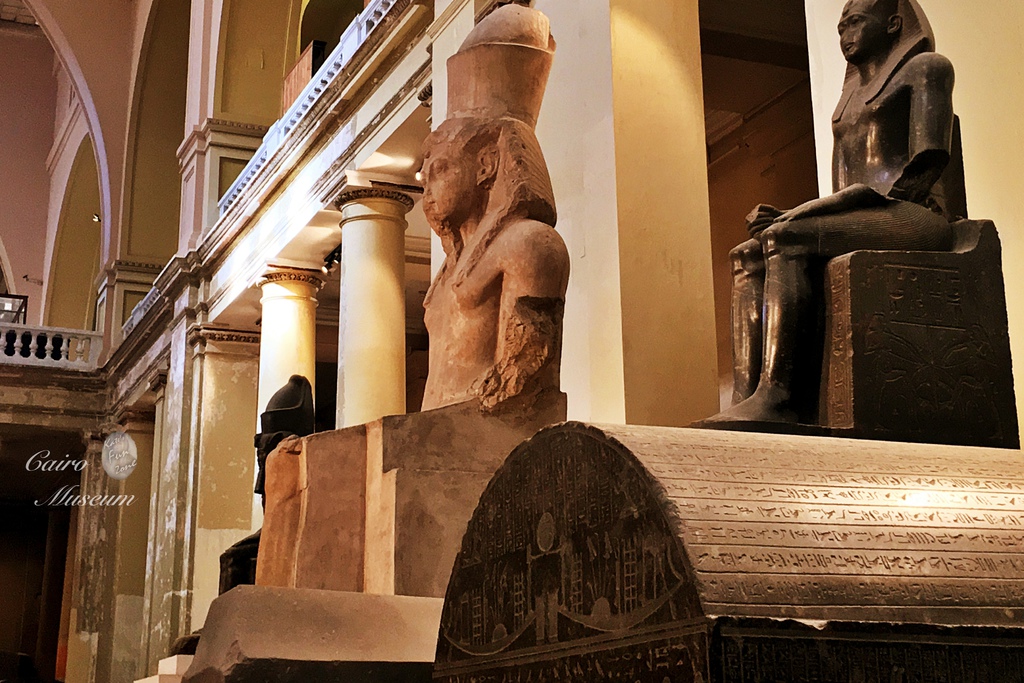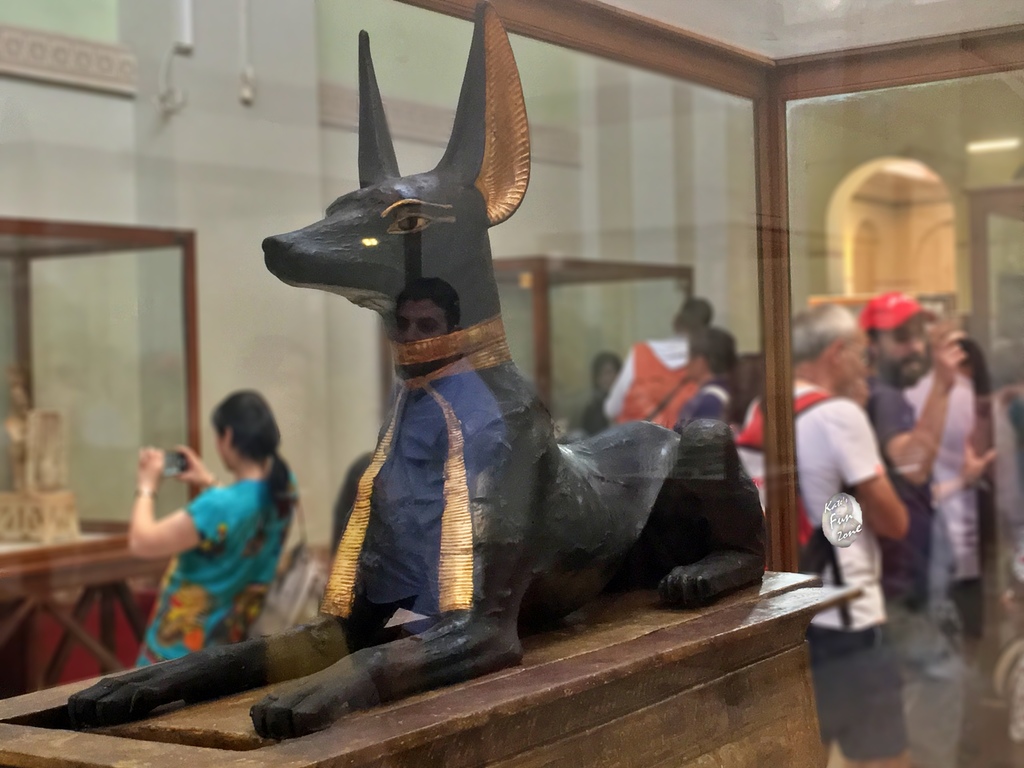The Egyptian Museum was the first attraction of the ancient Egyptian kingdom after we arrived in Egypt, so we were very excited and looking forward to it.

The Egyptian Museum is located in Cairo. The museum houses more than 120,000 treasures, and a small part of it are exhibited to the public.
At present, Egypt is building a new “Grand Egyptian Museum” in Giza (near the Pyramids site). It is expected to be open next year if goes as planned –the opening of this new museum, which has been built for more than a decade, has gone through numerous delays –. The new and spacious museum would allow more Egyptian ancient artifacts to be displayed.
The facade of the Egyptian Museum really made me a bit stunned. After all, I thought it should be as magnificent and majestic as the ancient Egyptian monuments. However, after seeing the architecture of the museum in person, I couldn’t help but come to a variety show–“Wait, that’s all?”
It was smaller than expected. Even though there are a few Egyptian statues placed on the plaza in front of the museum, it still appears to be somewhat shabby as an world-known museum. Especially when accommodating a large number of tourists, the plaza seemed even more crowded and narrow. It might be that I was being superficial, but I thought that such a famous and nationally representative museum should be a majestic and admirable building like, say, the National Palace Museum (Taipei), the British Museum (UK), or the Metropolitan Museum (United States). But for Egyptian Museum… I have to say that it gave me a illusion of coming to a luxury villa instead of a national museum.

📌 Coupon for Travels!
🏠Accommodation
Agoda(Sale Now!)
Trip.com
Booking.com
Hotels.com(Limit Sale,Save up to 75%!Book 10 nights and get 1 night for FREE!)
✈️Flight
🚩Follow「Kate’s Fun Zone」for more travel info!
When you travel in Egypt, keep 1 principle in mind: You have to pay for EVERYTHING.
Which means when entering almost any indoor attractions, it cost extra tickets (photo ticket) to take photo indoors. It is not that I hold any prejudice against Egypt, but how developed is a country could easily be seen from their management of those well-known tourist attractions.
I thought it was to protect the portrait rights of the artifacts to set the extra photo ticket (although it doesn’t make sense either). But after I entered the museum, I found that everyone was taking pictures, and no staffs were really checking on who buys the photo ticket or not. Therefore, people realize that the photo ticket is just to make more money out of tourists. Upon realizing this fact, tourists would not be fooled again since they can still take pictures without paying extra (but there is a security check at the entrance of the Egyptian Museum There, not sure whether people without photo ticket would be allowed to bring camera inside).
Well, we knew nothing that I mentioned above then as here was the first ancient cultural site we visited in Egypt. So we followed what the tour guide told us –no photo ticket, no photo–, and some of us even spent extra 200 egypt pounds for the photo ticket and regretted after entering the museum. I didn’t pay so I left my camera on the bus. Therefore, please understand for the bad photo quality of my smartphone.

▲ The three statues on the main entrance are of the goddess Hathor, the wife of Horus.
The plants in the pool in the middle of the plaza are the most representative plants in Egypt, papyrus and lotus.


▲ If you missed to change money at the airport, there is also a money exchanger at the museum.

Ignoring the appearance or the management of the museum, it is still exhilarating to step into the museum. Especially when seeing the two giant statues of Pharaoh on each side of the entrance, with each of them wearing Pschent, the crown after the unification of the upper and lower Egypt.
◆ Knowledge of Egypt: Ancient Egypt was divided into upper and lower Egypt in prehistoric Egypt. The terminology “Upper” and “Lower” derives from the flow of the Nile from the highlands of East Africa northwards to the Mediterranean Sea. As a result, to the north was Lower Egypt, where the Nile stretched out with its several branches to form the Nile Delta. To the south was Upper Egypt, stretching to Aswan.

▲ Pschent.(Jeff Dahl – CC BY-SA 4.0)
There are two floors of the Egyptian Museum.
Exhibitions on 1st floor is arranged by timelines, with a total of 42 exhibition halls, exhibiting artifacts from the period of the ancient Egypt to the Roman rule; on 2nd floor is arranged by themes, with 47 exhibition halls in total, including mummies, papyrus, hibiscus, and Tutankhamun’s exhibition room.
Anyway, to sum up, the Egyptian Museum is way too large to finish in one visit.
Particularly in the case of the group travel, we barely had free time to see around.
It would be such a pity that we come all the way here to Egypt while only took a glimpse at these precious relics. Therefore, I strongly recommend to take your time to admiring these ancient treasures.
◆ There is also a “Mummy Hall” that collects several generations of pharaoh mummies for an extra charge of 180 Egyptian pounds. Personally speaking, this Mummy Hall is not a must as the ordinary exhibition are remarkable and numerous enough.

▲ In the middle are statues of Amenhotep III and Tiye.
I can’t help but to say that the exhibits in Egyptian Museum are not very organized. Many items were placed and piled up unprotected nor arranged in the corners, as if I was entering a large warehouse—well, you can put it as if taking an adventurous hunting (?).
A large part of the exhibit on the first floor is coffin, with many carvings on it. In addition, a special part of the exhibit is the stone table which Egyptian made mummies.


▲ Benben stone from the Pyramid of Amenemhat III, Twelfth Dynasty.
If you have read the Japanese comic“Yu-Gi-Oh!”, then you should find this stone to be familiar –yap, this Benben Stone, the stone at the top of the Egyptian pyramid, is the prototype of the Millennium Puzzle in the story.


+ The Luxurious Grave Goods of King Tutankhamun
In 1922, the entrance to the tomb of Pharaoh Tutankhamun was finally discovered in the Valley of the Kings. Because it was very well-concealed, it took the archaeologists 19 years to discover. But this also allowed the grave goods–more than invaluable 100,000 ancient artifacts– in it to be well preserved, thus becoming the most luxurious tombs found in Egypt. Consequently, it is called “one of the greatest archaeological discoveries of the 20th century” and “the first of the world’s top ten treasures.”
On the second floor of the Egyptian Museum, there is a huge section exhibiting these grave goods of Tutankhamun, including:

▲ Tutankhamun’s Coffin
There would be many layers of coffins for ancient Egyptian monk’s mummy, the degree of luxury differs by their identity.
For example, there are four layers of Tutankhamun’s coffins, with a delicate structure design.
For the bottom right of the picture above, it is the outermost layer of Tutankhamun’s coffins. It is not only as large as a single room, but is also made of 450 pounds of gold. It is the most exquisite and greatest artifact made of gold in history.

▲ Tutankhamun’s Canonic jars
Someone should know the function of these four jars–to place the mummy’s organs.
The Canonic jars we usually see is simple and plain, which are totally different from what of Tutankhamun, that is, extraordinarily luxurious and refined. It is solely made of Alabastro Egiziano (✱ Note), a precious stone, and the top is carved in the head of Tutankhamun. The outer box is shaped as a temple, and on the four corners are goddess protecting the deceased. Their blessings words are engraved in the center on four sides.
✱ Note: Alabaster in ancient Egypt is the symbol of connection between present- and afterlife, as well as the meaning of “becoming”.

▲ Tutakhamun’s Chair for Ceremony
Speaking of Tutankhamen, he got many chairs for different uses, all of which the decoration is exquisite, beautiful, delicate.
For the one above, there’s a large vulture, on the back of the chair, with its wings wide open, which is the embodiment of the goddess Nekhbet, guarding Pharaoh. There are red dots on both side, which is the Sun disc representing the god Aten– an aspect of god Ra–. Below the sun disk is the name of the god Aten written in hieroglyphs.
▼ The Ka Statue of Tutankhamun (Left)
In ancient Egypt, they used “ka” as the concept of the soul.
They placed this statue at the entrance to the tomb as a guardian of Tutankhamun’s mummy.
Black has a symbol of regeneration in ancient Egypt, so the statue’s skin is painted black.
Besides of the goods mentioned above, some of Tutankhamun’s coffins, golden masks, and other precious grave goods are displayed in an independent exhibition room. But photos are not allowed inside (whether you have bought a photo ticket or not).

▲ (Right) Akhenaten, or called Amenhotep IV, who was also a famous Pharaoh.
Originally, Egypt believed in the sun of the god, Amon; however, Akhenaten replaced Amon with the god of Aten, made it the only god of Egypt (it is well known that there are countless of numbers of gods in Egyptian myth), and made himself the only connection between the real world and the god. So, it is not hard to imagine how upset were the priests at that time with this Pharaoh.

▲ Akhenaten also has a very unique coffin – a transparent crystal glass coffin.

▲ The Famous Anubis
In Egyptian mythology, whether it is the guardian of the dead, or the role of weighing the heart, Anubis is the god whose role is always connected with death. This can explained why the Anubis we usually see is painted in black, apart from the meaning regeneration, black also symbolizes the underworld.
We made various speculations about what kind of animal Anubis is, such as dogs, cats, foxes and wolves. As Wiki puts it, Anubis is said to be a jackal. Why jackal? As it is said that there are jackals showing around the graves, eating dead bodies that have just been buried. Therefore, the ancient Egyptians made the mummies guardian: Anubis into a jackal like figure, placing it around the mummies, hoping to scared(quite of?) the real jackals away.


▲ The Mummy of Thuya
On the second floor, there is an area for a couple: Yuya and Thuya.
Yuya was a powerful minister in ancient Egypt, and Tuyu was a rich woman at that time. Their daughter had even become the queen of Amenhotep III.
The golden masks, coffins, and even the mummies, along with other grave goods of them are exhibited here.
Although their coffins can’t be compared with Tutankhamun, they are also fairly delicate. Yuya’s with 4 layers of coffins and Thuya’s with 3 layers.

▲ Yuya’s Chariot

Finally, on the way to exit, there will be a souvenir shop.
The things here are more expensive than the merchants at other attractions, as well as the Khalili market. I would recommend to save your money elsewhere unless there’s something you really want it so badly.
(Extended reading: Khalili Market – The best place to buy Egyptian souvenirs)
Egyptian Museum
Address:Tahrir Square rd Tahrir Square، Egypt
Ticket :160 L.E.
Opening Hour:09:00- 19:00

